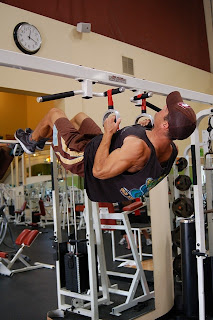 Guest blogger: Dr. Karin Anderson
Guest blogger: Dr. Karin AndersonThis morning at the gym, I saw a morbidly obese woman, with the unfortunate “apple” distribution of fat around her midsection. She was, predictably, doing situps. My first thought was “well, good for her for doing something.” Making a commitment to exercise and showing up at a gym to do it takes a lot of courage. My second thought was “
too bad she’s doing the wrong thing.”
I am going to beat this dead horse one more time, because it’s worth saying again: SPOT REDUCTION IS A MYTH. But for some reason, this belief really persists in people, and they will not give it up, no matter what science says. In order
to shrink your midsection (or any body part),
you need to lose fat. This is done by achieving a negative calorie balance. Period. Through diet or exercise, or, ideally, both.
You have to expend more energy than you consume, and that makes the fat go away. So if this woman finishes her situps and then goes out to Starbucks for a venti something-or-other, it will all have been in vain. Yes, doing situps does burn calories. But she could have burned three times as many on the treadmill.
Many people (and this includes a friend of mine who is a doctor) believe that the body will recruit the fat it burns from the area you’re working. So, they believe, if you work your abs, the body will use abdominal fat for fuel. This is, pardon the expression, a bunch of crap.
Metabolism is very complicated, so this is only a very general description. When the body needs fuel – glucose – and doesn’t have enough in store, it uses fat. The fat is transported from where it is stored to the LIVER (in case you were wondering, the transport molecule for this is HDL cholesterol), where it is converted to glucose. The glucose is then transported to the active muscle. So there is no advantage to using any particular fat store, since it all goes to the liver for processing. Which fat stores does the fat come from? It’s a little bit from everywhere, but more from some areas than others. Where it comes from is determined by genetics and hormones, and is almost ENTIRELY BEYOND OUR CONTROL. Men and post-menopausal women tend to have really stubborn abdominal wall fat. This is hormonal. They can do situps all day long, and their bodies will still pull fat according to its predetermined pattern.
If you maintain a negative calorie balance, eventually it will all come off, you just don’t get to control what shrinks first. It’s a little bit like accounting, though: last in, first out – the last place you gained fat is most likely to be the first place from which you lose it.
Yes, it’s frustrating. You start an exercise program. You start eating right. You keep track of your intake and output so that you are sure to have a negative calorie balance. And you want to see your belly shrink. Instead, your boobs disappear and you don’t notice any change in your belly at all. It can really make you want to poke your eyeballs out. But keep at it, and you will see the changes you want.
Now a few words about resistance training. If diet and exercise (when I say “exercise” I mean cardio) are the keys to fat reduction, what is the point to resistance training? Despite what I’ve said above, resistance training and calisthenics are extremely important. They burn calories, especially if you have a pretty vigorous resistance training program, although cardio still gives you more bang for your buck in terms of burning calories. What
resistance training does is build muscle. Muscle, being metabolically active tissue, burns calories, even at rest, so it makes the whole process easier. It makes you stronger, so you can do more things. It increases tension on your bones, making your bones stronger. And it just plain looks good:
a six-pack really is a beautiful thing.
So back to the woman at the gym this morning: if the situps I was observing were just part of her overall plan that included eating sensibly and a good cardio program, then I am wrong and I apologize for thinking what I did. The combination of all three activities is exactly what she needs to do. If not, then I hope that somehow she is pointed in the right direction. But if even one person learns something from this, then maybe all her situps were not in vain.
Standing by to answer your questions!________________________________________________
Dr. Karin Anderson is an
Emergency Room Physician in the Greater Dallas-Ft. Worth area so she definitely knows how to deal with stress. Karin is also a
dedicated physical fitness athlete who clearly knows the human body. Teammates, get on board to pick up some great tips from her knowledge of both disciplines.
 Guest blogger: Mark Friedman, President, Perfect Fitness
Guest blogger: Mark Friedman, President, Perfect Fitness















































